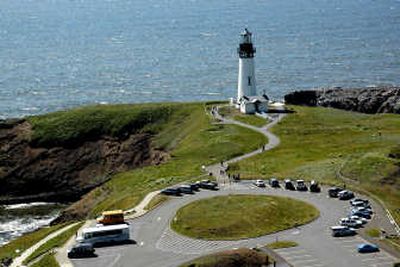Lighting the way

If you can visit only one lighthouse on the Oregon Coast, Yaquina Head near Newport makes a good choice. This historic site, situated on a point of land out in the ocean with an interpretive center with its operating light, has it all.
Lighthouses have a distinct reputation for giving a people a warm, secure feeling. They represent a guiding light that will keep us out of harm’s way. They are a beacon of brightness that leads us into a safe port and away from a rocky encounter. All the remaining lighthouses along the coast have their own personalities, histories and charm. From the Cape Blanco light at the farthest south location to the Tillamook Rock light in the north, they all have a story to tell. Some of them are tall and stately, others are short but they all had, and many still have, a vital role to play in keeping the shipping lanes safe for the many passing ships.
The lights were built before the time of radios, radar and satellite positioning, and were spaced along the coast so that one could always be seen by the captains of the wind-driven ships with canvas sails stretched out on tall masts. The light pattern of two seconds on, two seconds off, two seconds on and 14 seconds off is Yaquina Head’s unique “signature.” Local fishing captains have it memorized. The oil lamp was replaced in 1966 by an 1,000-watt electric bulb but the original lens is still being used.
Yaquina Head is the tallest of the Oregon lights at 93 feet. It took 370,000 bricks to build the double wall structure. It was built with a double wall of bricks to withstand the brutal winds and rain arriving from the sea. Although the light is high above the ocean, sea spray can drench it with water during winter storms. Rocks from the cliffs below have been known to be lifted up and break windows of the lighthouse.
When the lighthouse was built in 1872, the bricks and other materials were not easy to transport to the construction site. All the building materials had to be transported by schooner to Newport and transferred by horse-drawn wagon to the rugged, rocky point of land. This was no small job back in those days. The lenses were made in France and transported to New York, then portaged across Panama and shipped to San Francisco.
After the light was completed, every night the light keeper climbed the 114 stairs to light the oil lamp. The Coast Guard maintained and kept visitors off the premises until 1993 when it was turned over to the Bureau of Land Management and was designated as the Yaquina Head Outstanding Natural Area. Now it is possible to follow the light keeper’s steps, climbing the stairs to the top of the lighthouse.
It seems that most lighthouses have stories of ghosts in and around them. Yaquina Head is no exception. But visitors need not worry because the light is closed and locked at night. It is reported that ships passing close to shore have encountered problems with their compasses, but in more recent times it was discovered that the explanation was a magnetized vein of iron under the lighthouse rather than some ghostly phenomenon.
What makes this site appealing, besides the obvious tall lighthouse, is that the BLM offers a visitor center at the same location. Inside, the Oregon Coast lighthouses are subjects ranging from exhibits of construction, light keepers’ diaries and stories, ghosts, to the animals, birds and fish found around the lights. A full size replica of a lens complex used in all the lighthouses is exhibited. A first-order Fresnel lens found in Yaquina Head is explained. There is a road and handicap accessible trail that descends about 90 feet to the shoreline where tide pools with sea stars, anemones and other tidal creatures can be explored. Behind the light, toward the mainland is another trail that climbs above the lighthouse providing a panoramic view north and south, up and down the spectacular shoreline. The protruding point of land out in the sea is also an excellent place to watch migrating gray whales in season.
Light from the Yaquina Head Lighthouse can be seen almost 20 miles out to sea but reaches inland as far as Idaho. Last year more than 400,000 visits to the light make this one of the most popular destinations on the coast. For those who enjoy lighthouses, put this one on your to-do list.